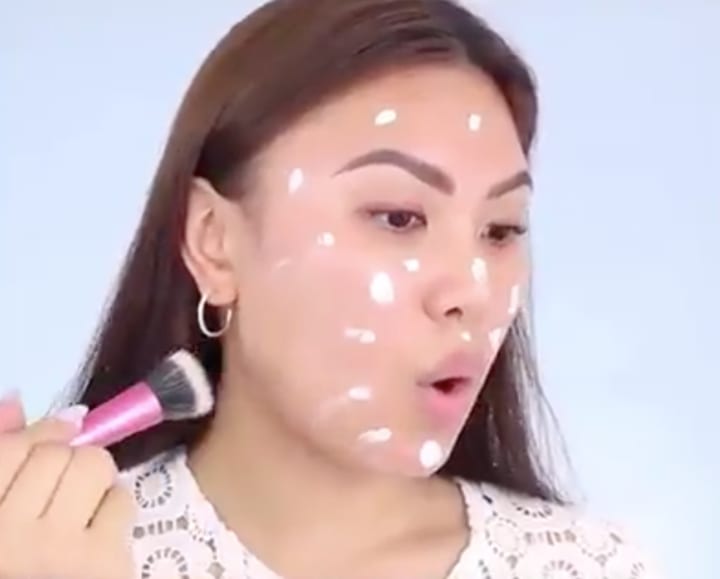Perfect Foundation vs The History of Mexico
Trying to find my color while not knowing how dark I am
My skin is the color of Mexican nationalism. I am a product of (at least) Indigenous and Spanish roots on both sides of my family, from Northern and Southern Mexico, from flour and corn tortillas. Mexico was one of the first colonized countries that advocated for miscegenation, because it would “whiten” the entire country, and the mixed race people could be known as La Raza, as foretold and advocated by José Vasconcelos. I grew up saying “Para La Raza!” (for the race) without knowing the originally racist implications - now I say “para la gente!” (for the people). Because being Latinx is an ethnicity and not a race, then people of many races are Latinx. You don’t even have to speak Spanish to be Latinx, as Brazil and Haiti are Latin American countries. However, having been raised in the Southwestern US, I grew up with the understanding that I looked like the stereotypical Latina. I’m brown with brown eyes, black hair, and short with a round face, and when I talk quickly or with strong emotion, my Chicana accent comes out. Now, I know that not all Latinx people have to look or be like me, even other Mexicans don’t look like me, since I have been trying to surpass the anti-Blackness and anti-Indigeneity taught in Mexican culture.
In the 1920s Mexico, there was a resurgence in politics and the arts called Indigenismo, with the arts movement headed by none other than Los Tres Grandes - Diego Rivera, Jose Clemente Orozco, and David Alfaro Siqueiros. Diego Rivera and Jose Clemente Orozco were the perfect encapsulation of the Indigenismo movement, since
“Rivera was an indigenista who idealized the Indian segment of Mexican society and glorified pre-hispanic culture. Orozco was a hispanista who admired the Spanish conquerors as a civilizing force in a barbaric world.”
Before the 1920s, Mexican art was styled after European art. With the Indigenismo resurgence, a more vibrant and less precise art style came about, emphasizing Indigenous features. The irony is that there is a grand history, even up to current attitudes, of anti-indigeneity. Mexican nationalism tries to paint the picture that all Mexicans are mestizos, products of Indigenous and Spanish blood. This thinking has invaded many Mexicans' psyche, so that even white Latinx people that look European think that they are brown. I am brown, but I might think that I am darker than I actually am.
My family is one of mestizos, and melanin is a coin toss across each individual. My mom is quite light-skinned, although I resist calling her white-passing because she has not experienced life that way with her Mexican name, round face, and body. My dad is darker, with a common name and the kind of stereotypical look that gets him stopped at state and national borders. To give you a better idea, I was at an Indigenous Arts museum in Oklahoma, and they had plaques with the artists’ pictures on them. I did a double-take on one because he looked like my dad. Meanwhile, my mom’s mom has green eyes and straight hair, each an example as of her own mestizaje, with green eyes from her Spanish-descent father, and her straight hair from her Yaqui grandmother, and this kind of hair associated with being indio, usually a negative connotation of being indigenous-descent in Mexico. She spent years paying for perms to not look india. My dad’s dad had straight black indio hair, and made fun of whoever looked just like him for looking or acting indio. History presents itself differently in my brother and I. He is darker and tans easier, and he has our grandfather’s curls. I am also brown, with curls but that could be from either parent’s side. I identify as Xicana, using an “X” instead of “Ch,” because the X more prominently recognizes being indigenous descent. Yet, according to the US census, my whole family is white. The US census does not ask if any of us have ever been mistaken as white (we haven’t). The US census certainly didn’t ask the customs officer who asked me “Where were you born?” when I re-entered the country from a mission trip in Ecuador, asking immediately after I handed him my US passport.
Yesika Salgado, a Salvadorian-American poet, said everything I’ve wanted to and more in the post below. I cannot deny my mestizaje, but I know it benefits me in some ways while detrimental in others. I know colorism benefits me where racism does not.
So, the history of Spain, Mexico, mestizaje, immigration, and the American Dream brought me here, looking at an Instagram ad on Instagram, in my primary language of English, born and raised in the US. I kept seeing the ad for a color-matching foundation that changes to match your skin tone, over the course of several weeks. I kept seeing a woman’s surprised face several times over the magic of the color-changing make-up foundation. It was the antithesis to my face of confusion when my light-skinned mom and I shared foundation, even though I swear I have more melanin. Eventually, I caved to the ad, thinking I would never have to buy a foundation with a color name or number again - this one would just adjust to me!

Of course, it never arrived, because the website was a scam. I have since become more suspicious of social media ads, even for the Instagram ad for Vocal because it seemed too good to be true… sometimes it still seems that way…
I have since looked up reviews of the actual color-changing foundation, and it does not hold up well. It did change colors, but not in the most flattering tone, especially for dark-skinned people.
I have no reviews for a product - I have a review on Mexican nationalism. It does more psychological and physical harm (such as cruelty towards Central American immigrants) harm than good. Mexican nationalism is on my face and in my mind, trying to erase the anti-blackness and anti-indigeneity inherent in wanting everyone to be of mixed blood/race so all can whiten “up,” even though Black and Indigenous Mexicans are grand influences in Mexican culture.
Alas, although this seemingly perfect foundation hasn’t found its way to me yet, and I will continue to be confused about the shade and racial classification that I am, I am proud to be brown, and proud to be resisting Mexican Nationalism to fight for faces darker than mine.
About the Creator
Ariana GonBon
27yo bi Xicana. There's always more to write about, in more interesting ways than white men. Follow me @arte.con.ariana, all tips will go to @openyrpurse, both on Instagram.







Comments
There are no comments for this story
Be the first to respond and start the conversation.